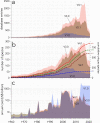Recent advances in availability and synthesis of the economic costs of biological invasions
- PMID: 37680688
- PMCID: PMC10481418
- DOI: 10.1093/biosci/biad060
Recent advances in availability and synthesis of the economic costs of biological invasions
Abstract
Biological invasions are a global challenge that has received insufficient attention. Recently available cost syntheses have provided policy- and decision makers with reliable and up-to-date information on the economic impacts of biological invasions, aiming to motivate effective management. The resultant InvaCost database is now publicly and freely accessible and enables rapid extraction of monetary cost information. This has facilitated knowledge sharing, developed a more integrated and multidisciplinary network of researchers, and forged multidisciplinary collaborations among diverse organizations and stakeholders. Over 50 scientific publications so far have used the database and have provided detailed assessments of invasion costs across geographic, taxonomic, and spatiotemporal scales. These studies have provided important information that can guide future policy and legislative decisions on the management of biological invasions while simultaneously attracting public and media attention. We provide an overview of the improved availability, reliability, standardization, and defragmentation of monetary costs; discuss how this has enhanced invasion science as a discipline; and outline directions for future development.
Keywords: InvaCost; economic impacts; environmental management; guiding policy; invasive alien species.
© The Author(s) 2023. Published by Oxford University Press on behalf of the American Institute of Biological Sciences.
Conflict of interest statement
All authors declare that they have no conflicts of interest.
Figures



References
-
- Ahmed DA, et al. 2022. Managing biological invasions: The cost of inaction. Biological Invasions 24: 1927–1946.
-
- Akerlof K, Maibach EW, Fitzgerald D, Cedeno AY, Neuman A.. 2013. Do people “personally experience” global warming, and if so how, and does it matter? Global Environmental Change 23: 81–91.
-
- Aloo PA, Njiru J, Balirwa JS, Nyamweya CS.. 2017. Impacts of Nile perch, Lates niloticus, introduction on the ecology, economy and conservation of Lake Victoria, East Africa. Lakes and Reservoirs: Science, Policy and Management for Sustainable Use 22: 320–333.
-
- Angulo E, Ballesteros-Mejia L, Novoa A, Duboscq-Carra VG, Diagne C, Courchamp F. 2021a. Economic costs of invasive alien species in Spain. NeoBiota 67: 267–297.

